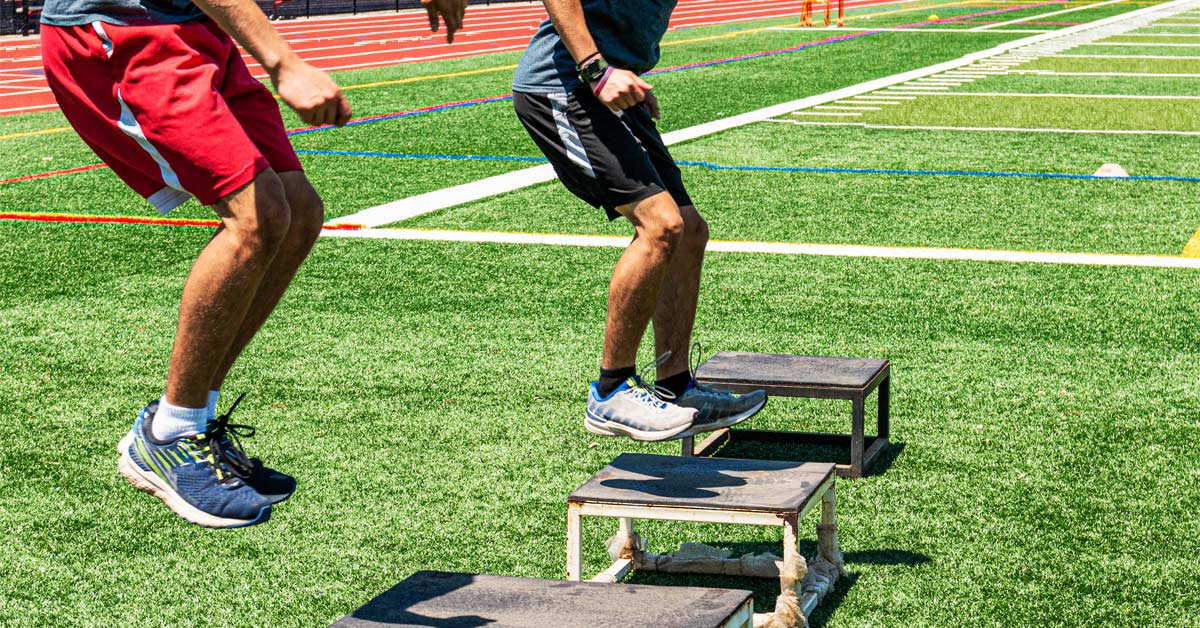[mashshare]
There are so many more reasons to love and appreciate working at the high school level and, in particular, on a high school campus, but the one that I feel is often overlooked is the colleagues we work with. I’m lucky not only to work on a collaborative campus with some of the brightest teachers in Florida, but I have numerous teachers in close quarters who I call family. Working in near proximity to teachers has not only changed my outlook on the “how’s” of coaching, but also the “why’s” of doing it. There is so much we can learn from teachers and the principles of education; admittedly, they are resources that I ignored for far too long in my own coaching experience.
Working in near proximity to teachers has not only changed my outlook on the “how’s” of coaching, but also the “why’s of doing it, says @John_Garrish. Share on XAs the saying goes, coaching is teaching, and teaching is coaching. Although some of these principles directly apply to programming strategies—i.e., an emphasis on motor learning and teaching movement patterns—the more important ideas run a little bit deeper than that. It’s important to note that although not all of these ideas are universally accepted, they are principles that I’ve absorbed and practice as a result of learning from the teachers around me.

The Student Comes First
This isn’t to say that we shouldn’t look out for ourselves and each other as professionals, but as educators, we’ve agreed to an unwritten oath of unconditionally putting our students and their growth first. As a result of this idea, we’ve adapted our training program to a more autoregulative and autonomous approach. Readiness reports and surveys let the students know we care about how they feel and value their feedback. Accepting their feedback to adjust their training creates a sense of identity and ownership in the program, just the way it does in the classroom.

Every Student Matters
In the team setting, sometimes we get lost in the sauce of wins and losses, trends and standards. I love working in a group setting because I get to see a large number of young people come together around a common goal. However, when we’re caught up in “getting with the program,” we can sometimes outcast the outliers.
I think it goes without saying that it doesn’t matter how much a young person contributes on the field; they should still be coached with the same attention given to a future Division 1 All-American. I suppose the more controversial thought would be that this is especially true for us as high school coaches because we are not hired or employed for the sole purpose of bringing more wins. I could be nearsighted, but I have yet to hear of an administration-hired high school strength and conditioning coach being fired for losing games.
We encourage every student to participate in our S&C program, and I think the diversity of participants is the most enjoyable part of being a high school strength coach, says @John_Garrish. Share on XWe encourage every student to participate in our strength and conditioning program, especially those who are resistant at first. I think the diversity of participants is the most enjoyable part about being a high school strength coach. There’ll be times in our room when we have kids from every sport and non-sport, with different abilities and individualized learning plans on campus. The differentiated progressions and regressions they find in the weight room are similar to what they experience in their classrooms.

Parents Are the Ultimate Support Staff
Most strength and conditioning coaches, and coaches in general, considering a start or move to the high school level have concerns with eventual parent interaction. One of my unfortunate thoughts was that I didn’t want anything to do with parents because all I read were the headlines and all I heard were the horror stories. This led me to avoid parents like the plague during my first couple years working at the high school level. As a result, any time I heard from a parent it was because of a concern they had or bad news. Full disclosure: It was usually a failure on my part to communicate with them!
Midway through year three, I decided that I would over-communicate with parents, and instead of being reactive, I’d be proactive and include parents in as much as possible. What I found was parents who wanted to participate and contribute, and students who heard echoes of what they heard on the weight room floor at their dinner table. If you want the ultimate “buy-in,” start with the parents—the students will follow.
 Never, Ever Give Up on a Child
Never, Ever Give Up on a Child
Children are not miniature adults and, thankfully, are still growing and changing. One of my greatest regrets as a high school coach is holding on to a first, second, or even third impression of a few students for too long and allowing that impression to get in the way of instructing and mentoring them. I think it’s a standard rallying point for strength coaches, especially in a college environment, to form a “get with it or get lost” mentality, and that was something I clung to for my first few years.
What I’ve realized now, after a few years of experience, is that some of the most strongly forged mentorships with young people start with or include some form of early conflict. If you write off a high school student every time they act up or fail to follow orders, you’ll be left with nobody to coach. In a voluntary training environment like ours, my hot-headed self was not nearly as productive in building a program as I am now, coming from a position of patience and understanding.

Stress Is Stress
One of the great things about being a high school performance coach is being able to be around 14- to 18-year-old kids all day. On one hand, some of their “problems” are laughable—the relationship stress, the worry of getting a B+ instead of an A on a test, Instagram shutting down, etc. On the other hand, some of our students have faced circumstances and seen things that I couldn’t fathom, putting some of my own “problems” into perspective.
From a training standpoint, it’s important to realize that any stress we might add to a young person’s plate is likely magnified because of their emotional state, says @John_Garrish. Share on XThese stressors, no matter how big or small, captivate the young high schooler’s mind and are often all they can think about. From a training standpoint, it’s important to realize that any stress we might add to a young person’s plate is likely magnified because of their emotional state.

Inspiration Is the Most Potent and Contagious Tool
We’ve all seen the movies that depict two types of classrooms: one that’s lifeless and unmotivated, with an uninterested teacher; and one that’s vibrant and full of passion, with students from similar walks of life who are lucky enough to have a teacher who’s optimistic enough about young people that they create a classroom climate and culture of positivity. One story comes from a place of pessimism, of “the teacher’s always right,” of disregarding circumstances and faulting “kids these days.” The other features a teacher who sees the classroom as a student-centered place of growth and problem-solving, not just for the students but for themselves.
Walk down any high school hallway and you’ll see classrooms just like each of these, side by side, with the exact same students at different times. It isn’t the room number or the decorations on the wall; it isn’t even the subject matter that’s inspiring or failing to inspire the students—it’s the teacher. Similarly, walk by the sport practices after school and you’ll find similar contradictions in inspiration, fire, and excitement. We challenge kids to never take the easy way out and tell them there’s no easy button in life, yet as coaches, we hit the easiest easy button of them all by using the “kids these days don’t care” excuse as cover for our own lethargic programming.

Some of the Most Successful People Were the Worst Students. Some of the Best Athletes Are the Worst ‘Workers.’
More likely than not, a main reason we get into teaching and/or coaching is because we’ve been personally influenced by a teacher or coach in the past. I can say with even more certainty that we serve in the role that we do because we believe in the value of the classroom and/or the weight room and probably worked hard in them when we were our students’ ages. Not all of our students will become teachers, just as not all of our athletes will become strength coaches, and that’s all okay.
Everyone’s interests will be about as different as their genetic gifts, and although once in a while the highest performers are the hardest workers, this is far from always the case. Just because a young person doesn’t “get it,” it doesn’t mean they lack drive or motivation; it doesn’t mean the child doesn’t want to succeed. Albert Einstein dropped out of school at 15, and I haven’t read too much about his “laziness.” I’d be equally surprised to find that the 20 American dropouts who became billionaires did so without some semblance of motivation.
There are plenty of athletes, especially young athletes, who have excelled without the weight room or with minimal work in the weight room. That’s not to say that their luck won’t run out or that others won’t eventually catch up as a result of their own hard work, nor is it to say that the weight room and the classroom are unimportant. Instead, I mean to bring perspective to a young person’s beliefs for why they might (wrongly) think the classroom or weight room is “not for them,” because they’ve had success without it.
The weight room needs high performers as much as high performers need the weight room, so it’s necessary to inspire both the student and the team to see the direct benefit. I’ve found many of the students who’ve outperformed their weight room work ethic have done so due to a motivation on the field/court that’s not lacking. The student has it in them, and nine times out of 10 wants to succeed in their sport; their means of doing so is what’s misconstrued.
Students will undoubtedly see the benefit of a long-term S&C program, but to get there it takes a passionate, understanding educator to turn on the switch for them, says @John_Garrish. Share on XThe fulfillment and direct mark of improvement with a ball in their hands or on their field of play seems closer than the gains made in the weight room that are just one step away from what they feel on the court. With time and experience, students will undoubtedly see the benefit of a long-term strength and conditioning program, but to get there it takes a passionate, understanding educator to turn on the switch for them.

Failure Is a Necessity
In my competitive years, I had frustrating tendencies that didn’t bode well for my “bad” practices. Whenever I had a practice that didn’t run without a hiccup, I’d get frustrated and, in the words of Tony Holler, I’d (mentally) “let today ruin tomorrow.” That meant not only would I be frustrated and mentally captured for the rest of practice, I’d try harder the next day and think somehow that would fix things.
One of the benefits of studying sports psychology in graduate school was being around classmates who were smarter and a lot more level-headed than me. A classmate of mine pointed me toward a better approach to practice; what he called a “no bad practices” approach. If you had said this to me before that day, I would’ve assumed it was a rally cry from my high school coach demanding perfection at every practice. Instead, it was an ideological outlook and approach to practice that would change my own perspective when things didn’t go “right.”
Instead of thinking “I did something wrong” at practice, I began to think “I found something I can improve on” instead. When all of our practices go so well that there’s nothing to improve on, I’d hope our team is winning because the ceiling is a bad place to be in a losing locker room.

If You Don’t Enjoy It, They Don’t Enjoy It
Children are really good at sensing and modeling energy. Weight rooms often reflect the energy of the coach just as a team usually takes on the mentality of their coach. That mentality could be reflected and presented in many different ways, and no two people have the same demeanor. However, one absolute non-negotiable is that, as educators, we see the value in what we do and there is enjoyment in what we do. Not every atmosphere is easygoing—that’s not the point—there are programs that are successful on both sides of the coin. The enjoyment is found in the outcome.
Weight rooms often reflect the energy of the coach just as a team usually takes on the mentality of their coach, says @John_Garrish. Share on XIn education, students (and teachers) usually find joy in the acquisition of new information. In training, athletes (and coaches) usually find the joy in acquiring new skills or bettering old ones to aid development on the field of play. If teachers/coaches and students/athletes don’t share this joy, then there is a very low likelihood for success in their arena. For coaches, it doesn’t matter where the lack of enjoyment stems from, the kids will sense it and mirror it. Much like some of the previous points on inspiration, this is largely the responsibility of the teacher or coach.
Teachers Benefit Us All
The benefits of working on a high school campus are endless and, of course, begin and end with the kids. However, working alongside teachers has been a tremendously rewarding experience not only for me personally, but for how I coach, interact, and program for our students. There are thousands of ways the teachers of our community have helped our strength and conditioning program; unfortunately, I couldn’t list all of them in the confines of this article. Teachers are generally loyal, honest, and goodhearted people who make great colleagues, but their greatest quality of all is their absolute selflessness and sacrifice for the betterment of our children.
Since you’re here…
…we have a small favor to ask. More people are reading SimpliFaster than ever, and each week we bring you compelling content from coaches, sport scientists, and physiotherapists who are devoted to building better athletes. Please take a moment to share the articles on social media, engage the authors with questions and comments below, and link to articles when appropriate if you have a blog or participate on forums of related topics. — SF
[mashshare]



